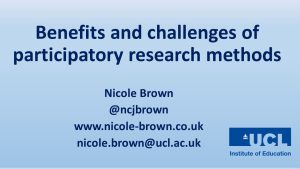
Source: NBrown
This video about the benefits and challenges of participatory research builds on my original work presented at the PASAR conference in 2017. The video was submitted for the qualitative stream at the 75th annual conference of the American Association of Public Opinion Research.
The benefits and challenges of participatory research methods
In recent years, research reports and articles highlight the benefits of participatory and creative methods in yielding richer data, and in better addressing the power differentials between researchers and the researched. However, reports on problematic issues in relation to the introduction of creative, participatory, collaborative elements are less prominent. In my presentation, I will draw on my own research to explore some practical, ethical and moral challenges.
My research focuses on the lived experience of chronically ill and/or disabled academics and in order to uncover the marginalised voices of these unheard and underrepresented academics I regularly use participatory and collaborative elements, such as identity boxes, collages and LEGO model making. In my paper, I present a brief overview of my research using making and doing to encourage participants to reflect on, make sense of and express their experiences, which are usually difficult to express in words.
In the second part of my paper I explore the difficulties and less successful aspects of the making processes and creative methods. Whilst the identity box has allowed non-academics to engage deeply in reflective tasks they are not necessarily used to, academics are reticent to embrace creative methods and approaches. This experience of academics struggling with the participatory elements as research participants is in stark contrast to the increased trends towards these approaches. Additional challenges for using creative methods are issues around time and commitment leading to high drop-out rates, which is also due to the disabling and unpredictable nature of their lived experience of chronic illness and/or disability. Finally, I will reflect on the difficulties relating to the boundaries between research, conversations amongst peers and therapy, and the role the researcher plays within this triad.
The slides and resources I used for this interactive presentation can be downloaded in PDF from here.
The video below is the recorded presentation as submitted to AAPOR.
Leave a message: